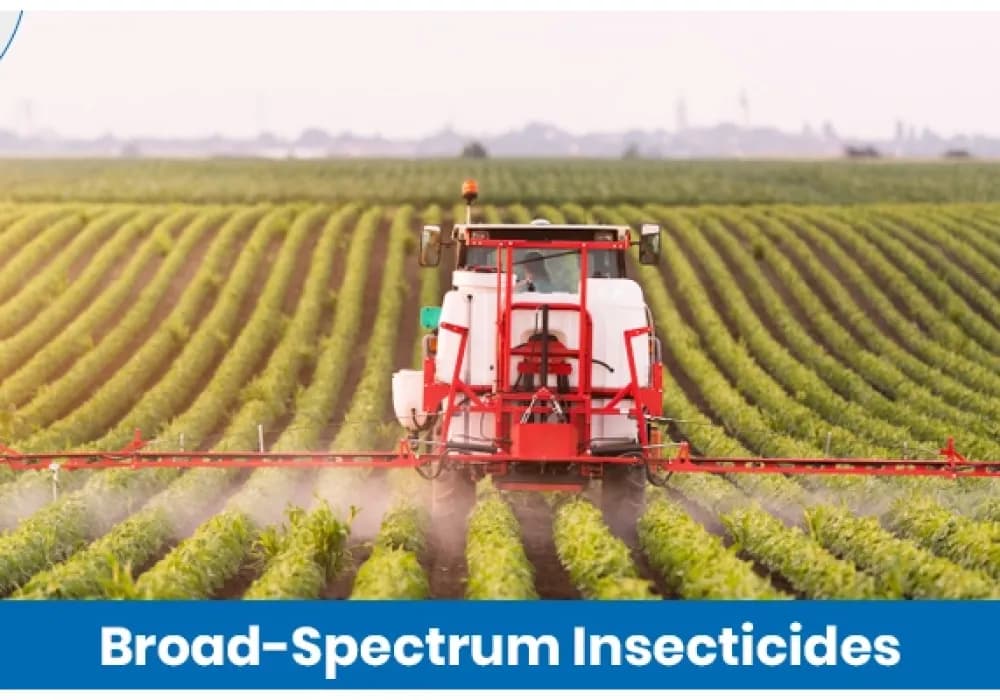In agriculture, insects can cause severe crop losses if not controlled in time. Unlike the case of using certain insecticides that kill specific pests, broad-spectrum insecticides target many insects at a time.
This may be of assistance when farmers have been struggling with different pest cases in the same field. In simple terms, broad-spectrum insecticides work like a single-spray solution that targets multiple pests at once.
How Broad-Spectrum Insecticides Target Multiple Insect Types
Broad-spectrum insecticides either target the nervous system, digestion, or the growth cycle of the insect.
It will control chewing pests like caterpillars, leaf beetles, and borers, and sucking pests like aphids, jassids, and whiteflies since it exhibits a broad spectrum of action.
This wide range of spectrum does not compel you (farmers) to use a variety of sprays against a variety of pests and assures fast coverage of crops.
Shared Biological Vulnerabilities
Broad-spectrum insecticides often interfere with biological systems, no matter of their size, shape, or feeding style. These are common across diverse species of insects. For example:
- The nervous system is the most common target. Insecticides like organophosphates or pyrethroids block nerve signal transmission. This can block enzymes like acetylcholinesterase or keep sodium channels open, causing overstimulation, paralysis, or death.
- Lead-chewing or sap sucking insects ingest toxins during the feeding process. This largely impacts insects that chew, crawl, or fly.
- Insecticides, such as carbamates, affect the enzymes in the gut. Others like Bt-based but broader formulations highly affect the gut membranes, causing internal bleeding.
- Oils, soaps, or fumigants clog spiracles (breathing holes) or disrupt oxygen exchange, affecting insects such as mites, aphids, and caterpillars in a similar manner.
Application Pathways
Broad-spectrum insecticides do not rely on a single route of exposure. This affects insects in multiple ways:
- Insects are poisoned when their exoskeleton or legs touch treated surfaces of the farm.
- Lead-chewing or sap sucking insects ingest toxins during the feeding process.
- Vapors from fumigants penetrate the respiratory systems in enclosed areas.
Long Lasting Residual Effects
Diverse broad-spectrum insecticides stay active after application, some of them are:
- Residues on leaves kill insects that arrive later. In addition, soil treatments protect your farm and roots from multiple soil-dwelling pests.
- Structural applications (walls, floors, stored grains) keep killing insects for long after spraying.
- This persistent presence ensures the control of diverse pest groups.
Commonly Used Broad-Spectrum Insecticides in Indian Agriculture
Here is a list of broad-spectrum insecticides commonly used in Indian agriculture.
|
Category |
Common Active Ingredients / Products |
Target Pest Types |
|---|---|---|
|
Organophosphates |
Chlorpyrifos, Agni Plus, Superban |
Soil, chewing, sucking pests |
|
Synthetic Pyrethroids |
Deltamethrin, Cypermethrin, Bifenthrin |
Chewing, sucking, and household pests |
|
Neonicotinoids (Systemic) |
Imidacloprid, Thiamethoxam, Acetamiprid |
Sucking pests (aphids, jassids, hoppers) |
|
Phenylpyrazoles & Others |
Fipronil, Actrex |
Soil and field pests |
|
Diamides & Advanced Solutions |
Chlorantraniliprole (Coragen), Profenofos combos, Alika, Oberon, Spinetoram |
Caterpillars, borers, mites, whiteflies |
1) Organophosphates and Their Combinations:
- Chlorpyrifos: It is widely ued in crops like paddy, cotton, sugarcane and groundnut. It acts thorough contact, stomach and fumigation routes, targeting pests such as bollworms, termites and stem borers.
- Suburban 20 ( Chlorpyrifos 20% EC): An ideal option for soil insects (root grubs, termites, cutworms), for seed treatment and foliar applications in cotton and paddy.
- Agni Plus 505 ( Chlorpyrifos + Cypermethrin): Combining organophosphate and synthetic pyrethroid for broad spectrum action can be effective against borer pests, chewing and sucking insects alike.
2) Synthetic Pyrethroids
- Cypermethrin: Fast-acting, contact and stomach poison common in crops like cotton, maize, mustard, and vegetables.
- Deltamethrin 11% EC (Deltin Super): Potent broad spectrum pyrethroid, effective against bollworms, hoppers, caterpillars, and even household pests, offering contact and ingestion-based control.
- Bifenthrin 10% EC (Bofors): It covers bollworms, whiteflies, termites, leaf folders and hopper pests, which is widely used across cotton, sugarcane and tea.
- Bofors Plus ( Bifenthrin + Clothianidin): A combination formula addressing white grubs, aphids, termites, jassids, mealy bugs, and others across groundnut, cotton and soybean.
3) Neonicotinoids and Systematic Insecticides
- Imidaclopid 70% WG (Admin): A systemic insecticide to manage sucking pests like jassids, aphids, thrips, and plant hoppers across cotton, rice, okra, and cucumber.
- Thiamethoxam 25% WG (Etara): It is known for rapid stomach and contact action, which is used against rice pests like stem borer and hoppers, and plant hoppers in cotton, vegetables and pulses.
- Acetamiprid 20% SP: Systematic neonicotinoid effective against sucking pests (aphids, jassids, whiteflies) in crops like chilli, cotton, rice, and vegetables.
4) Phenylpyrazoles and Other Novel Modes
- Fipronil: Unique mode of action compared to other broad-spectrum insecticides, as it has contact, ingestion, and systemic actions. Very effective against soil and foliar pests of cotton, and is gaining popularity.
- Actrex (Thiamethoxam 25% WDG): Provides rapid stomach and contact activity against stem borer and other hoppers and sucking pests on rice, vegetables, and cotton.
5) Diamides and Advanced Molecules
- Chlorantraniliprole 18.5% SC: Lepidopteran and other chewing pests are easily managed with this systemic contact insecticide from the anthranilic diamide class, which has long-lasting action and is low toxicity to beneficial insects.
- Coragen or Profex Super (Chlorantraniliprole): Targets fruit borers and caterpillars, particularly in vegetable crops.
- Profex Super (Profenofos + Cypermethrin): Broad-spectrum dual-action insecticide against aphids, thrips, bollworms, and caterpillars.
- Syngenta Alika (Lambda-Cyhalothrin + Thiamethoxam): ZC formulation for the control of aphids, leafhoppers, whiteflies, and stem borers in various crops.
- Bayer Oberon (Spiromesifen): Controls mites, whiteflies, and other sucking pests.
- Spinetoram (Dow Delegate): Provides effective control of caterpillars, fruit flies, and leaf miners on vegetable and fruit crops.
How Broad-Spectrum Insecticides Reduce Crop Loss Caused By Insects
Farmers find it particularly challenging to contend with crop losses due to pest attacks. Caterpillars nibbling on leaves or aphids sucking on plant livestock can cause losses of 15-30% within most Indian crops. Also, the broad-spectrum insecticide is crucial in mitigating the losses due to its ability to control insect pests simultaneously.
Killing Multiple Pests at a Time:
In most fields, it is common to find different pests, and an example is a cotton crop infested with bollworms, aphids, and whiteflies. Instead of applying different targeted products, a general insecticide can be applied to the entire crop, killing all pests at once.
This is time-saving. The cost is reduced. Also, the general insecticide helps to save the farmer from the losses due to the rapid increase of pest damage that would otherwise occur in the absence of control measures.
Fast Knockdown Effect:
With the broad-spectrum, the general insecticide is the other chemical of pest control that acts within a short time and kills the targeted pests by touch, ingestion, or fumigation. The high percentage of pests killed in a short time ensures that the pests do not breed or multiply and spread to other parts of the field.
Pests that are in the early stages of infestation cause a lot of damage to crops. With the general insecticide, it is possible to protect the plants from damage during the appropriate development stages.
Residual Protection Against Late Invaders:
Many broad-spectrum insecticides continue to work even after spraying is complete. These insecticides provide a protective cover, or protective residue, over the surface of the plants.
This protects the plants from later-arriving insects, such as leaf chewers, sap suckers, or even soil grubs. This continuous protective cover is critical in crops such as rice, vegetables, and cotton, which face continuous pest pressure throughout the season.
Disruption of the Pest Lifecycle:
Insects reproduce rapidly, and small infestations can become large outbreaks in weeks. Broad-spectrum insecticides can disrupt the lifecycle of nymphs and larvae, preventing future infestations. This ensures that the new generations of pests do not emerge to cause significant yield losses in the future.
Safety and Usage Guidelines for Effective Results
The proper use of broad-spectrum insecticides provides defense against many pests that can damage crops. The effectiveness of the insecticides can, however, be injurious. To achieve the desired outcome whilst maintaining safety in farming, the following must be followed.
Start with the Label:
The instructions on every insecticide cover parameters on how it should be mixed, the right dosage, along directions on how it should be applied. The label provides complete guidance to ensure safe and effective use. Sticking to it maximizes control while minimizing the risk of damaging the crops or soil.
Self-Care Comes First:
As with any other harmful substance being sprayed, protective gear should be worn well in advance. This includes gloves, masks, goggles, and long clothing. A couple of minutes of preparing the gear can keep you away from unintended contact with the chemical.
Select an Appropriate Time:
Arranging the calendar properly can also be useful. Spraying during the earlier or later stages of the day improves efficiency and enables the protection of beneficial insects, such as bees. Pesticides should be applied in calm and dry conditions to minimize wastage and reduce the risk of drift.
Avoid Shortcuts:
The application of every product used in the spraying and harvesting process has a pre-harvest interval (PHI). This is the gap that must be maintained in between in order for the final product to be safe for the market.
FAQs

K SANJEEVA REDDY
CHIEF AGRONOMY OFFICER
Sanjeeva Reddy K. serves as the Chief Agronomy Officer at AGRIBEGRI TRADELINK PVT LTD, a role he stepped into in July 2025, where he oversees and manages agronomy expertise across the organization. He holds a Postgraduate degree in Agricultural Science from Tamil Nadu Agricultural University, India, and is a Certified Crop Advisor accredited by the Indian Society of Agri Professionals, in association with the American Society of Agri Professionals. With more than 20 years of experience in crop production, Reddy has built extensive expertise working across reputed agribusiness industries. A significant part of his career includes a decade-long tenure with the internationally recognized Indian brand MULTIPLEX, a leading Bangalore-based manufacturer and marketer of plant nutrients, where he played a key role in driving growth and innovation.
